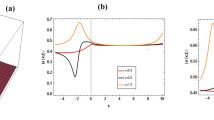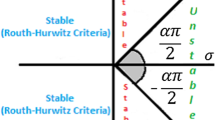Abstract
This paper attempts to shed light on three biochemical reaction-diffusion models: conformable fractional Brusselator, conformable fractional Schnakenberg, and conformable fractional Gray-Scott. This is done using conformable residual power series (hence-form, CRPS) technique which has indeed, proved to be a useful tool for generating the solution. Interestingly, CRPS is an effective method of solving nonlinear fractional differential equations with greater accuracy and ease.
Similar content being viewed by others
References
G Adomian. The diffusion-Brusselator equation, Comput Math Appl, 1995, 29: 1–3.
Marius Ghergu. Non-constant steady-state solutions for Brusselator type system, London Mathematical Society, 2008, 21: 2331–2345.
S Islam, A Ali, S Haq. A computational modeling of the behavior of the two-dimensional reaction-diffusion Brusselator system, Appl Math Model, 2010, 34(12): 3896–3909.
R C Mittal, R Jiwari. Numerical solution of two dimensional reaction-diffusion Brusselator system, Appl Math Comput, 2011, 217(12): 5404–5415.
R Jiwari, J Yuan. A computational modeling of two dimensional reaction-diffusion Brusselator system arising in chemical processes, J Math Chem, 2014, 52: 1535–1551.
W R Holmes. An efficient, nonlinear stability analysis for detecting pattern formation in reaction-diffusion systems, Bull Math Biol, 2014, 76(1): 157–83.
J D Murray. Mathematical biology II: Spatial models and biomedical applications, Berlin, 2003.
K M Owolabi, K C Patidar. Higher-order time-step** methods for time-dependent reaction-diffusion equations arising in biology, Appl Math Comput, 2014, 240: 30–50.
P Gray, S K Scott. Autocatalytic reactions in the isothermal, continuous stirred tank reactor: isolas and other forms of multistability, Chem Eng Sci, 1983, 38(1): 29–43.
P Gray, S K Scott. Autocatalytic reactions in the isothermal, continuous stirred tank reactor: oscillations and the instabilities in the system A + 2B → 3B, B → C, Chem Eng Sci, 1984, 39(6): 1087–1097.
A M A El-Sayed, S Z Rida, A A M Arafa. On the Solutions of the generalized reaction diffusion model for bacteria growth, Acta Appl Math, 2010, 110: 1501–1511.
S Rida, A Arafa, A Abedl-Rady, H Abdl-Rahaim. Fractional physical differential equations via natural transform, Chin J Phys, 2017 55: 1569–1575.
A Arafa, G Elmahdy. Application of residual power series method to fractional coupled physical equations arising in fluids flow, Int J of Diff Eq, 2018, 2018, 10 pages, doi: https://doi.org/10.1155/2018/7692849.
A A M Arafa, A M S H Hagag. Q -homotopy analysis transform method applied to fractional Kundu-Eckhaus equation and fractional massive Thirring model arising in quantum field theory, Asian-Europ J Math, 2019, 12: 11 pages, doi: https://doi.org/10.1142/S1793557119500451.
S Z Rida, A M A El-Sayed, A A M Arafa. Effect of bacterial memory dependent growth by using fractional derivatives reaction-diffusion chemotactic model, J Stat Phys, 2010, 140: 797–811.
V Gafiychuk, B Datsko. Stability analysis and oscillatory structures in time fractional reaction-diffusion systems, Phys Rev E, 2007, 75: 055201, doi: https://doi.org/10.1103/PhysRevE.75.055201.
B I Henry, T A M Langlands, S L Wearne. Turing pattern formation in fractional activator-inhibitor systems, Phys Rev E, 2005, 72: 026101, doi: https://doi.org/10.1103/PhysRevE.72.026101.
J Singh, M M Rashidi, D Kumar, R Swroop. A fractional model of a dynamical Brusselator reaction-diffusion system arising in triple collision and enzymatic reactions, Nonlinear Eng, 2016, 5: 277–285.
A Tahavi, A Babaei, A Mohammadpour. Analytical approximation solution of a mathematical modeling of reaction-diffusion brusselator system by reduced differential transform method, J Hyper, 2014 3: 116–125.
M Y Ongun, D Arslan, R Garrappa. Nonstandard finite difference schemes for a fractional-order Brusselator system, Adv Difference Equ, 2013, 2013, 102, doi: https://doi.org/10.1186/1687-1847-2013-102.
H Jafari, Abdelouahab Kadem, D Baleanu. Variational Iteration Method for a Fractional-Order Brusselator System, Abst Appl Anal, 2014, vol 2014, 6 pages, doi: https://doi.org/10.1155/2014/496323.
H Khan, H Jafari, R Ali Khan, H Tajadodi, S Jane Johnston. Numerical Solutions of the Nonlinear Fractional-Order Brusselator System by Bernstein Polynomials, The Scient World J, 2014, 2014, 7 pages, doi: https://doi.org/10.1155/2014/257484.
E Pindz, K M Owolabi. Fourier spectral method for higher order space fractional reaction-diffusion equations, Commun Nonlinear Sci Numer Simul, 2016, 40: 112–128.
A A M Arafa, S Z Rida, H Mohamed. Approximate analytical solutions of Schnakenberg systems by homotopy analysis method, Appl Math Model, 2012, 36: 4789–4796.
A A M Arafa, A M S H Hagag. A new analytic solution of fractional coupled Ramani equation, Chin J Phys, 2019, 60: 388–406.
A A M Arafa, S Z Rida, M Khalil. The effect of anti-viral drug treatment of human immunodeficiency virus type 1(HIV 1) described by a fractional order mode, Appl Math Model, 2013, 37: 2189–2196.
A A M Arafa, S Z Rida, A A Mohammadein, H M Ali. Solving nonlinear fractional differential equation by generalized Mittag-Leffler function method, Commun in Theor Phys, 2013, 59: 661–663.
A A M Arafa, M Khalil, A Sayed. A Non-Integer Variable Order Mathematical Model of Human Immunodeficiency Virus and Malaria Coinfection with Time Delay, Complexity, 2019, 2019, 132 pages, doi: https://doi.org/10.1155/2019/4291017.
M A Bayrak, A Demir. A new approach for space-time fractional partial differential equations by residual power series method, Appl Math Comput, 2018, 336: 215–230.
M A Bayrak, E Ozbilge. A New Approach for the Approximate Analytical Solution of Space-Time Fractional Differential Equations by the Homotopy Analysis Method, Adv Math Phys, 2019, vol 2019, 12 pages, doi: https://doi.org/10.1155/2019/5602565.
R Khalil, M Al Horani, A Yousef, M Sababheh. A new definition of fractional derivative, J Comput Appl Math, 2014, 264: 65–70.
O S Iyiola, O Tasbozan, A Kurt, Y Cnesiz. On the analytical solutions of the system of conformable time-fractional Robertson equations with 1-D diffusion, Chaos Solit Frac, 2017, 94:1–7.
H Thabet, S Kendr. Analytical solutions for conformable space-time fractional partial differential equations via fractional differential transform, Chaos Solit Frac, 2018, 109: 238–245.
Emrah Unal, Ahmet Gokdogan. Solution of conformable fractional ordinary differential equations via differential transform method, Optik, 2017, 128: 264–273.
A Kurt, H Rezazadeh, M Senol, A Neirameh, O Tasbozan, M Eslami, M Mirzazade. Two effective approaches for solving fractional generalized Hirota-Satsuma coupled KdV system arising in interaction of long waves, J Ocean Eng Sci, 2019, 4: 24–32.
O Tasbozan, M Şenol, A Kurt, D Balean. Analytical and numerical solutions for time-fractional new coupled mKDV equation arising in interaction of two long wave, Asia Pac J Math, 2019, 6:3, doi: https://doi.org/10.28924/APJM/6-13.
O Tasbozan, M Senol, A Kurt, O Ozkan. New solutions of fractional Drinfeld-Sokolov-Wilson system in shallow water waves, Ocean Eng, 2018, 161: 62–68.
M Senol, O Tasbozan, A Kurt. Numerical Solutions of Fractional Burgers Type Equations with Conformable Derivative, Chin J Phys, 2019, 58: 75–84.
A El-Ajou, O Abu Arqub, S Momani, D Baleanu, A Alsaedi. A novel expansion iterative method for solving linear partial differential equations of fractional order, Appl Math Comput, 2015, 257: 119–133.
S Das. Functional fractional calculus, Springer Science Business Media, 2011.
I Podlubny. Fractional Differential Equations, Academic Press, New York. 1999.
Author information
Authors and Affiliations
Corresponding author
Rights and permissions
About this article
Cite this article
Arafa, A. A different approach for conformable fractional biochemical reaction—diffusion models. Appl. Math. J. Chin. Univ. 35, 452–467 (2020). https://doi.org/10.1007/s11766-020-3830-5
Received:
Revised:
Published:
Issue Date:
DOI: https://doi.org/10.1007/s11766-020-3830-5
Keywords
- Brusselator model
- Schnakenberg model
- Gray-Scott model
- conformable fractional derivatives
- residual power series method




